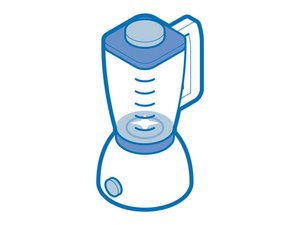Causes
The blade assembly is made of two parts typically: blades and bearings. By blending hard objects, blades will dull and cause the motor to work harder and overheat. Blades last an average of 6 months with moderately heavy use. Sharpen or replace the blades if they are dull.
The bearing inside the assembly may also fail from overuse and misuse. Some blenders, like the Vitamix, are intended for running at their max speed in order for the cooling fans to properly work. In some cases, the bearing seal may melt or otherwise disintegrate. Water will then infiltrate the bearings during cleaning and wash away grease and cause rust to form. Replace the bearings or entire blade assembly if the blade won't spin.
Where the motor and blade assembly connect is a drive gear. On blenders with plastic gears the teeth may wear down more quickly.
- Inspect that the gears mesh and aren't stripped.
- Use a large flat head screwdriver to remove and the gear if it's missing teeth.
On some blenders the drive gear and motor shaft may be threaded and have stripped threads. If the gear wobbles it's a good sign that it's stripped.
- Try wedging a screwdriver under the gear and turning the motor by hand to tighten the connection.
If it's too stripped, the manufacturer will likely recommend replacing the entire base. Try this fix.
- Glue together the shaft and rubber gear with a steel epoxy. This connection will be snug after curing.
Liquids find their way onto and into the motor base. The interface between the cup and the motor base is prone for fluid and grime accumulation. The activators are the three white switches that initiate the blending to begin by locking in the cup and should move up and down with a spring action.. You can test the activators by pushing the three switches down with a flathead screwdriver. If the switches will not move, add a few drops of warm water or vinegar into the activator slots and wait a few minutes before trying again.
A blender that is working too hard processing frozen foods, hard nuts, thick butters, flax seeds, cell phones, glow sticks, etc. will be working harder and may eventually burnout or stall.
Your blender may be equipped with a thermal breaker that shuts down the motor if it starts overheating, so while there's little risk of fire, the blender still might start smoking. If the blender is running for more than a minute on a low power speed, it's likely the motor overheating. Let the blender cool down.
You're seeing solutions for Blender. Select your model to find parts for your device.






